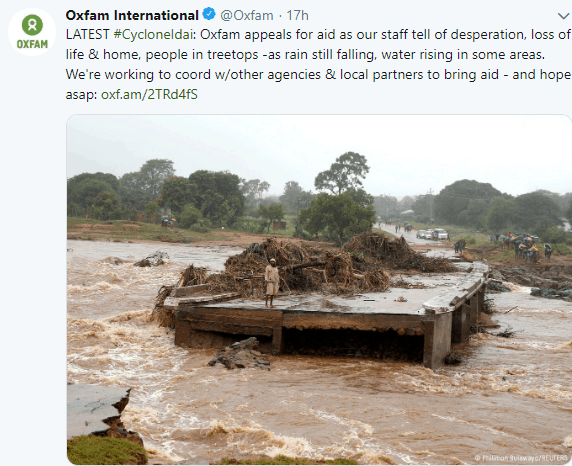Nearly a week after a deadly cyclone hit the southeast coast of Africa, it is still difficult for aid to reach survivors. Cyclone Idai slammed into Mozambique in the wee hours of March 15, when most people were likely asleep. It made a direct hit on Beira, a coastal city of around 500,000 people who didn’t evacuate. Powerful wind gusts of 175 mph destroyed homes, businesses, schools and most of the city’s hospitals. Mozambican President Filipe Nyusi said late Tuesday that more than 200 people have been reported dead so far in Mozambique.
The storm pushed tons of sand from Beira’s beach onto downtown streets, complicating emergency response efforts that were already stifled by a total lack of electricity, telecommunications networks or running water, according to Jamie LeSueur, Emergency Operations Manager for the International Federation of Red Cross and Red Crescent Societies. The organization is helping to lead emergency response efforts in Beira, and was one of the first aid groups to arrive there.
Hundreds of deaths were also reported in the neighboring countries of Malawi and Zimbabwe, where the storm triggered flash floods, high winds and mudslides, leaving people stranded on rooftops and in treetops. Although aid is now slowly coming into the region, many roads are still blocked by boulders, mud and debris. Floods washed away some bridges that connected a number of the most devastated areas, forcing military and aid workers to walk supplies to affected areas, rather than drive.
The main road leading out of Mozambique’s capital Maputo is closed. The only way for aid to reach the city has been by helicopter. According to The New York Times on March 19, more than a dozen aid trucks were stuck on roads outside the city.
Hundreds of thousands of displaced people across the region are in schools and churches that were not destroyed or badly damaged, waiting for clean water, food and medical attention. LeSueur said that aid helicopters have been dropping floating parcels into the floodwaters, using the draft from the choppers’ propellers to blow the packages close to those in need, trying not to destroy the structures that still stand.

The United Nations World Food Program (UN WFP), which rushed four tons of high-energy biscuits to Beira on Monday, has been distributing emergency food supplies and water to people in the area. On Wednesday, it began reaching areas inland from Beira.
“WFP is starting food distribution in Dondo today outside Beira,” said Deborah Nguyen, part of the WFP response in the port city. “Communities stranded by floods in Buzi and surroundings are being rescued by helicopters to Beira for now,” she added, referring to the area across the river from the port where thousands of people are believed to be stranded, and which the United Nations has warned risks being submerged. The Beira Airport (ICAO code: FQBR), one of the few spots that isn’t underwater or heavily damaged, is being used as a staging area.
Hundreds of people are reportedly still missing across the devastated region. Officials believe the death toll could rise to more than 1,000 as search-and-rescue efforts coordinated by the countries’ governments and the UN continue. Altogether, the UN estimates that up to 2.6 million people were affected by the storm, and said on Tuesday that it will need $40.8 million in emergency relief funding.
According to Kieran McConville, a spokesperson for the humanitarian group Concern Worldwide (which has operations in the affected countries), the storm will likely lead to food shortages lasting for months or years. A high percentage of the population are subsistence farmers; many of their small agricultural holdings have been destroyed. The storm hit just before the annual harvest season, damaging at least 330 square miles of crops, as well as killing an unknown number of cows and other livestock. Unfortunately, there’s more rain in the forecast in the coming days, making the work of rescue and recovery teams that much harder.











